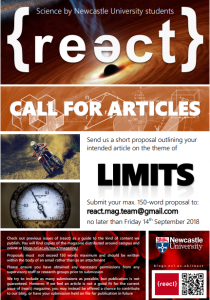by Emma Kampouraki
You should know {react} by now. If you are reading this, you’ve seen the magazine somewhere on campus, online, or you are even a fan of our blog. Be that as it may, you should have realized what {react} is trying to add to your everyday lives; a splash of science mixed with attractive design and high quality of photos.
But how did we end up there? Well, that’s an interesting story because no one is greatly confident to answer. {react} was born from a team of PhD students and a few members of staff who dreamed of a science magazine that would target a wide range of audiences, help people learn more about science, and most of all encourage students write more about science and the process of publication. {react} was soon much appreciated by the student community and, although this fluctuates, {react} often seems unable to accommodate the numerous interesting articles it receives for every issue. Then, the blog was created. It would be a pity for those articles to stay hidden in a hard drive.
A magazine would never come together without the co-operation of a big team that literally does everything from scratch. If you look at previous issues of {react}, the style slightly changes to reflect the influence of new members in the design team as well as popular demand for certain types of articles (such as research articles, as opposed to interviews). A large part of the character of {react} is its design. Another important bit is the articles themselves. And how these end up in print, is a long story.
To cut this story short, the call for proposals is announced by the team via social media, posters across campus, word of mouth and e-mail newsletters. When the deadline closes and according to the number of submissions received, we normally go through the process of reviewing the 150-word proposals and selecting the ones that reach our standards in terms of quality and fit with the pre-announced theme. Authors are then contacted with clear guidelines on how to produce their full-length articles. A sub-editor is allocated who can guide them through the process of reviewing the article and making the necessary changes to meet our publication standards. The design team comes last to format the magazine in such way that will be appealing to reach and enjoyable to read.
As in every team, we need a proper hierarchy system to ensure all needs are met within certain timeframes. This also ensures that messages are properly communicated and tasks are co-ordinated. The editor(s) organize the meetings and provide the team with guidelines and information. At the same time, the team makes decisions democratically. Positions in the committee include the sub-editors, the blog manager(s), the design team, the copy editor and the editor(s). These roles are allocated on a voluntary, first come, first serve basis during our recruitment events or training workshops. PhD students are preferred for the committee due to the nature of the magazine and to offer training opportunities for skills development; however, we have had Master students help out as well.
Issue 11 has just been published and will be available soon, both online and in print, available across campus and at most major student spots in Newcastle. It is the result of hard work, team effort and co-ordination of a great number of authors, reviewers and sub-editors. We couldn’t be prouder for this issue as it encompasses a variety of scientific topicsfrom different fields, which makes it more inclusive than ever. Join us in our training events to learn more about the magazine and, if you fancy, join our team to help bring science closer to the many audiences {react} targets and to celebrate the results of team work by a team of PhD students.
- Current call for proposals ongoing under theme “Limits”, deadline 14th September, 150-word article proposal to be sent to react.mag.team@gmail.com

- Upcoming training workshops:
Meet the {react} team – 12th November 2018
Meet the team behind our student-led science magazine, and learn how you can contribute as a writer, editor or designer
{react} training day – 20th February 2019
Join us for a suite of training sessions in science writing and communication delivered by experts in the fields of public engagement, science journalism and design